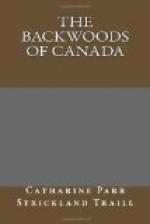Of Violets, we have every variety of colour, size and shape, lacking only the delightful viola odorata of our home woodlands: yet I know not why we should quarrel with these meek daughters of the spring, because they want the fragrance of their more favoured sisters. Many of your wood-violets, though very beautiful, are also devoid of scent; here variety of colour ought to make some amends for want of perfume. We have violets of every shade of blue, some veined with purple, others shaded with darker blue. We have the delicate white, pencilled with purple: the bright brimstone coloured with black veinings: the pale primrose with dark blue veins; the two latter are remarkable for the luxuriance and size of the leaves: the flowers spring in bunches, several from each joint, and are succeeded by large capsules covered with thick white cottony down. There is a species of violet that grows in the woods, the leaves of which are exceedingly large; so are the seed-vessels, but the flower is so small and insignificant, that it is only to be observed by a close examination of the plant; this has given rise to the vulgar belief that it blooms under ground. The flowers are a pale greenish yellow. Bryant’s beautiful poem of the Yellow Violet is descriptive of the first-mentioned violet.
There is an elegant viola tricolor, that blooms in the autumn; it is the size of a small heart’s-ease, and is pure white, pale purple, and lilac; the upper petals are white, the lower lip purple, and the side wings a reddish lilac. I was struck with the elegance of this rare flower on a journey to Peterborough, on my way to Cobourg; I was unable to preserve the specimens, and have not travelled that road since. The flower grew among wild clover on the open side of the road; the leaves were small, roundish, and of a dark sad green.
Of the tall shrubby asters, we have several beautiful varieties, with large pale blue lilac, or white flowers; others with very small white flowers and crimson anthers, which look like tufts of red down, spangled with gold-dust; these anthers have a pretty effect, contrasted with the white starry petals. There is one variety of the tall asters that I have seen on the plains, it has flowers about the size of a sixpence, of a soft pearly tint of blue, with brown anthers; this plant grows very tall, and branches from the parent stem in many graceful flowery boughs; the leaves of this species are of a purple red on the under side, and inclining to heart-shape; the leaves and stalks are hairy.
I am not afraid of wearying you with my floral sketches, I have yet many to describe; among these are those elegant little evergreens, that abound in this country, under the name of winter-greens, of which there are three or four remarkable for beauty of foliage, flower, and fruit. One of these winter-greens that abounds in our pine-woods is extremely beautiful; it seldom exceeds six inches in height; the leaves are a bright




